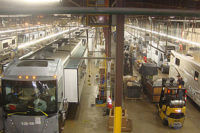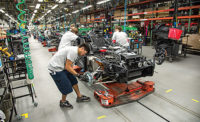Toyota Motor Corp. is synonymous with lean manufacturing. But, it’s not the only member of the Toyota family to embrace the concept. Forklift manufacturer Toyota Material Handling USA Inc. (TMHU), a division of Toyota Industries Corp., has been practicing and perfecting continuous improvement principles for decades.
The company’s 25-year-old plant in Columbus, IN, officially known as Toyota Industrial Equipment Manufacturing Inc. (TIEM), excels at lean material handling. Sequential delivery is critical to the success of the high-mix production facility, which builds more than 60 varieties of forklifts. Mixed-model assembly lines at the 1 million-square-foot plant are constantly being replenished with parts and components.
Lean Material Management
Toyota’s secret weapon is lean material management. “All manufacturers handle materials, but lean material handling is different,” says Richard Rahn, principal of Leonardo Group Americas, a consulting firm that conducts three-day workshops at the TIEM plant.
The six characteristics of a lean material flow system are:
- Material is pulled to the various points of use, not pushed. There are some exceptions to this rule, but they are few.
- The quantities that are stored at the points of use are small. “TIEM targets about a shift’s worth of material at various workstations on the assembly line,” notes Rahn. “Many items are moved one at a time, especially large, heavy items, such as counterweights and masts.”
- The deliveries to replenish materials are performed frequently. “At TIEM, there are 12 deliveries per day, on a cycle of about 35 minutes per delivery cycle,” says Rahn. “This frequency of delivery is unheard of in more traditional manufacturing environments.”
- Outside suppliers are included in the material flow strategy. Many domestic suppliers deliver via daily milk runs. Empty reusable containers serve as replenishment signals.
- Inventory turnover is high, exceeding traditional manufacturing environments by a factor of two or more.
- The material delivery system is highly error-proofed, and is subject to continual audits and improvements. Kanban cards are scanned and automatically analyzed during every replenishment trigger.
According to Rahn, issues with material management are the biggest challenge facing manufacturers today, especially as more parts and components are sourced from distant suppliers.
“Materials represent the largest percent of product cost (compared to overhead and labor) for most manufacturing companies, and materials are also one of the largest items on the balance sheet,” explains Rahn. “The biggest opportunity for manufacturers to free up working capital is to develop a lean material management system that includes suppliers.
“Traditional thinking says that material handling is ‘overhead’ or ‘waste,’ and needs to be reduced,” adds Rahn. “Participants in our class are always surprised at the amount of handling that TIEM seems to do, especially compared to their own plants. What is not usually considered, however, is the impact on operator productivity.
“When operators are not burdened with excess material at their workstations, and they always have what they need to assemble, productivity skyrockets,” claims Rahn. “And, since there are many more operators than material handlers, the net productivity gain to TIEM is highly positive.”
Rahn believes that many manufacturers fail to grasp that concept. They fall victim to several common misconceptions about lean material handling, such as
- Lean means having a lot less raw material than traditional manufacturing. “This is true, but what is not understood is the foundation of a lean management system—organizational discipline and error-proof processes,” says Rahn. “Without these, we hear people say: ‘Lean material methods don’t work at our company.’”
- Lean material handling is successful because workers submit lots of improvement ideas. “While the number of improvement suggestions at TIEM is high (an average of 1.5 suggestions per person per month), these ideas are small,” notes Rahn. Many of the ideas generate cost savings, but TIEM is interested in investing in employees' problem-solving abilities and empowering them to practice kaizen (continuous improvement) in their area of expertise. As they grow, their views become wider and their improvement ideas become larger, benefitting safety, quality and productivity throughout the plant.
- Material handling is waste, so a company should strive to do less of it. “Our students often comment about the level of material replenishment activity taking place at TIEM, with replenishment trips every 35 minutes,” Rahn points out. “This strikes them as wasteful. What they don’t understand is the impact this has on floor-space usage and operator productivity, which more than offsets the additional cost of handling.”
World-Class Plant
Toyota has been active in the material handling industry since the mid-1950s. Its first lift truck was built in 1956, followed by a tow tractor in 1957. Ten years later, Toyota sold its first forklift in the United States.
To meet growing demand, the company opened a $60 million state-of-the-art assembly plant in Columbus, IN, in 1990. Since then, TMHU has grown to become the No. 1 forklift supplier in North America. TIEM produced its 450,000th forklift in 2013; this month, the factory will produce its 500,000th machine.
“Over the past 25 years we have expanded 13 times and grown from 280,000 square feet to more than 1 million square feet,” says Tom Lego, customer center manager. “Lean material management has helped the Columbus plant be flexible, productive and enable TMHU to maintain its No. 1 status in the industry.
“One of the foundational pillars of the Toyota Production System is the idea of just-in-time manufacturing,” adds Lego. “This provides several benefits to our organization, including:
- Reduced inventory and carrying costs.
- Reduced material movement and material handling.
- Additional focus upon the importance of 100 percent quality for every part.
- Providing material as it is needed so that [assemblers] can perform consistent work, thereby improving their safety, productivity and quality.
- By building the product that is needed, in the quantities needed and at the proper time, we have additional manufacturing flexibility to meet changing customer and economic conditions.”
That flexibility proved invaluable six years ago, when TMHU experienced a 50 percent drop in sales during the Great Recession. The company was able to quickly readjust production schedules and redeploy resources. And, as the economy has improved in recent years, THMU has been able to ramp up its assembly lines accordingly.
“The material handling industry is a relatively small-unit business with many players and a huge amount of customization,” says Lego. “Over the years, we have [addressed] this complex product mix by becoming more flexible [and learning to produce] one by one or in very small quantities.
“In addition, as the variety of options and products has increased, we have not expanded the length of the line, but moved toward smaller portion deliveries to the individual process areas as parts are needed,” Lego points out.
TMHU has been able to consistently gain market share year after year because of its focus on customers and its willingness to customize their products. The Columbus plant builds 65 basic products, but there are thousands of options and combinations available. Almost 75 percent of all lift trucks on the assembly line require customer-specified components.
“A car buyer, in contrast, has very little ability to customize a car outside of the list of standard options and accessories,” says Rahn. “TIEM is much more willing to make modifications outside of their standard list of options. This makes it difficult for both line balancing and material delivery, but they are able to pull it off.
“TIEM is a classic mixed-model environment, with a high degree of product types being built on the same line,” adds Rahn. “However, the volume is not so high that the production lines need to be highly automated, as can be seen at other Toyota plants, like its car factory in Georgetown, KY.”
Last year, that plant produced 465,711 vehicles. In sharp contrast, TIEM’s Columbus plant assembled approximately 10 percent of Georgetown’s volume in 2014.
“Not all products can be mixed efficiently, but at TIEM, more than 50 different models are sequenced down the main assembly line,” notes Rahn. “Needless to say, the material delivery system needs to keep up with all of this variability, and not cause delays or line shutdowns.
“TIEM is the best example I’ve seen of this challenge working well,” claims Rahn. “This plant does a great job of executing lean material management and is the gold standard.”
Diverse Products
Toyota’s Columbus plant produces a wide range of industrial equipment used in a variety of indoor and outdoor environments, including three- and four-wheel electric lift trucks; internal combustion (gasoline and diesel) lift trucks; and compressed natural gas-powered lift trucks. The factory typically builds more than 160 vehicles a day and exports to 20 countries.
TMHU also is a leading manufacturer of automated guided vehicles (AGVs), in addition to stand-up and sit-down tow tractors. Those products are assembled at the "mother" plant in Takahama, Japan, and at a "sister" plant in Muscatine, IA. However, many of the devices are used to replenish assembly lines at the Columbus plant.
In addition to its U.S. facilities, Toyota builds forklifts at assembly plants in Brazil, China, France and Japan. But, 99 percent of Toyota forklifts sold in the United States are manufactured domestically.
Toyota produces a full line of lift trucks with capacities ranging from 0.5 to 40 tons. The vehicles are used in all types of factories, loading docks and warehouses. A variety of attachments make them adaptable for specialized applications, such as handling lumber, paper rolls and stone material.
Just about every product moving down the TIEM assembly line in Columbus is different. Most machines are painted orange, but it’s not uncommon to see forklifts painted blue, green or other colors that customers specify.
Products vary by engine size, lifting capacity, maximum lift speed and turning radius. Lifting capacity determines the type of mast and counterweights that are used on each product. For instance, two-, three- and four-rail masts are available.
Other variables include different types of front and rear axles, hydraulic cylinders and transmissions. TIEM assemblers build more than 35 types of fuel tanks, which each contain about eight separate components. Depending on the application, forklifts are equipped with either solid rubber, cushion or pneumatic tires.
Forklifts range in prices similar to automobiles, based upon various models and options. A basic middle-of-the-line vehicle generally costs around $25,000. TIEM sells each product it assembles to TMHU, which handles sales, distribution and service. It oversees a group of independent dealers at more than 200 locations in North America.
Line Leveling
The TIEM plant operates three assembly lines. One is dedicated to the small electric three- and four-wheel products. Another line builds the larger internal combustion products, and one assembly line is dedicated to midsized internal combustion and electric products.
One-third of the parts used in the factory come from Japan, such as engines and computer controls. However, the remaining parts are domestically sourced.
TIEM also prides itself on vertical integration. The plant builds a wide variety of subassemblies internally, such as front and rear axles, fuel tanks, hydraulic cylinders and overhead guards, which vary from vehicle to vehicle.
“We have become more vertically integrated over our past 25 years of manufacturing in Columbus,” says Lego. “In some cases, we identified specific areas that we felt strongly that we could better control our quality by manufacturing the parts in-house. In other cases, our investigation showed cost or small portion delivery benefits by bringing the work in-house.”
At TIEM, continuous line-side parts delivery plays a key role in the plant’s success. A wide variety of tugger trains circulate around the assembly and subassembly lines to enable quick replenishment throughout each shift.
The quick-response, small-amount material handling system is called a “water strider.” The lean philosophy behind it is that it’s better to take a light load and make frequent trips.
Assembly lines at TIEM are serviced by both human-operated tuggers and AGVs. “Toyota manufactures AGV equipment, but we realize that this is only one of many possible tools for material handling,” says Lego. “Based upon the frequency of the deliveries, the sizes, distances and other factors, we may determine that the best means for movement of parts to another process is by a conveyor, a hand-powered cart or pallet jack, a powered jack, a tugger, a forklift or an AGV.
“Currently, the AGVs are being used where we have a subassembly that is disconnected from the main assembly line, but where we need to deliver that subassembly in-process one by one to a specific area on the assembly line,” explains Lego. “There are always processes under review to determine if they should be using one of these different tools to more efficiently deliver the parts required from the next process.”
Engineers at the plant are constantly monitoring line leveling and line balancing to avoid producing the same model back-to-back and to even the workload over the production day. “A specific customer order may be produced over a week’s time, in order to level the workload,” notes Rahn. “They have a small dedicated team at TIEM that does nothing but this type of planning, and it’s critical to their success.”
“We call this leveling process ‘heijunka,’” says Lego. “We have the capability to move products from one line to another, but each has been specifically set-up to support these categories. If we were to see a large swing in demand, while it would require a great deal of work, we do have the ability to move products from one line to another.”
Due to certain “bottleneck” operations, those options or models that are considered to be harder or easier to produce change from month to month. The production control and manufacturing teams meet jointly each month to better understand how to best level production through these more challenging processes.
“The listing should change from month to month, as manufacturing continues to address these more challenging option and model combinations,” says Lego. “One easy example would be scheduling two four-stage masts back to back. Since these are more complex than two- and three- stage masts, we will try to avoid scheduling these masts back to back. The idea would be to insert a two- or a three-stage mast between each four-stage mast.
“Heijunka levels the amount of work that [assemblers] perform in each process to keep everything flowing smoothly,” adds Lego. “It also allows the kanban system to level the requirements to our suppliers, allowing them to begin production as they are signaled based upon our parts usage. Without this balancing, we spike demand from various manufacturing and supplier areas, causing disruption and moving away from the philosophy of ‘try to build each order one by one.’”
This material handling strategy has played a critical role in recent months, as demand has spiked due to the improving economy. “We have had to balance the short-term requirements and the long-term forecast to meet increased product demand,” says Lego. “Each month, we have three meetings with manufacturing planning and sales to understand these trends.
“Since this has been a more prolonged period of growth, we have made some changes to our production takt time, rebalancing the work throughout the various production areas within the plant,” Lego points out. “For more short-term requirements, we typically add some daily planned overtime and maybe a few Saturday production days to our plan. We share a rolling three-month calendar of our production planning with our suppliers and employees so that they can plan accordingly.”
Sequential Delivery
Sequential parts delivery also plays an important role in TIEM’s success. Inside and outside of the plant, engineers make sure that parts and material arrive just when they are needed on the assembly line.
“Throughout the manufacturing process, we are signaling the start and end points for these parts and subassemblies,” says Lego. “That enables us to ensure that components arrive at the correct time and in the correct sequence at the area where they will be needed.
“As we have grown and added additional products, options and special customer-requested design capabilities to our production, it has required that we do a better job of delivering small quantities of parts to the specific area where these parts are needed on a just-in-time basis,” explains Lego.
“We utilize sequential delivery of some components through a process we call ‘Junjo,’” Lego points out. “Other parts will be sent in small quantities through a Kanban system. Approximately every half hour, we have material handlers who replenish materials based upon what was consumed about two hours before.
“The Kanban system is the means by which we reorder materials,” adds Lego. “There is a small quantity of parts for each of the various types and options of lift trucks. The card is in a standard lot size of material.
“When we use the first piece from the box, the card is turned in, signaling that a reordering of this box of parts is needed,” explains Lego. “Based upon the lot size, parts usage and the lead time to reorder these parts, the system will calculate the correct number of cards (lot sizes) in the in-process inventory.”
TIEM relies on a network of suppliers located within a several hundred mile radius of Columbus, which is one hour south of Indianapolis. A daily “milk run” process allows TIEM to return the reusable containers and Kanban cards to each supplier and pick up parts that were ordered a few days earlier.
“This offset allows the supplier time to begin producing for a future pick-up once they receive the Kanban order and returnable containers,” says Lego. “By keeping small quantities of materials and only reordering when they are being consumed, we can maintain very low inventory quantities for our locally supplied materials.”







